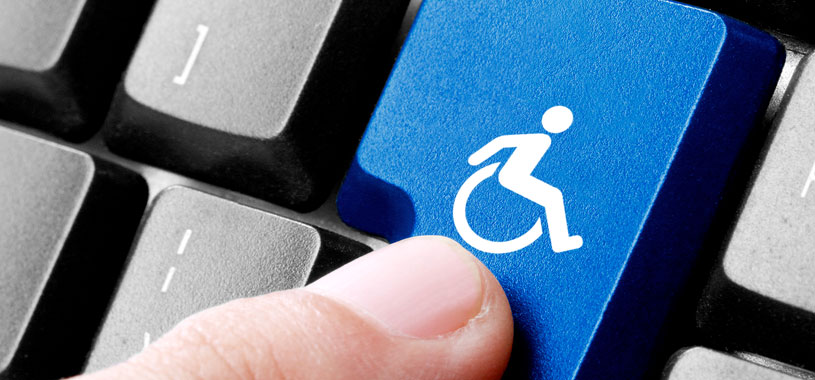 Web accessibility benefits all your learners and is not hard to achieve in your e-learning platform or the content you develop. What is web accessibility? It means making websites (and other web-based content and platforms, like your learning management system) usable to people of all abilities and disabilities. In this post we will look at 5 steps to making your e-learning platform more accessible. In 5 minutes or less, you will find out how accessible your current system is, how accessible your content is, and what steps you need to take to ensure both are accessible for all.
Web accessibility benefits all your learners and is not hard to achieve in your e-learning platform or the content you develop. What is web accessibility? It means making websites (and other web-based content and platforms, like your learning management system) usable to people of all abilities and disabilities. In this post we will look at 5 steps to making your e-learning platform more accessible. In 5 minutes or less, you will find out how accessible your current system is, how accessible your content is, and what steps you need to take to ensure both are accessible for all.
Step 1: Build a team
You’ll want to start by identifying representatives from key stakeholder groups. Make sure to not only include trainers, administrators, developers, and IT team members, but also learners with accessibility issues. You might also want to recruit an ‘ambassador’—someone who can be the face of your accessibility initiative and bring attention to the progress being made.
Step 2: Conduct an assessment
First, you’ll want to establish your minimum web accessibility requirements. Are you required by law or industry regulation to provide accessible web content?
Next, you’ll want to assess a sampling of your existing content. The tools listed below can help you simulate viewing web pages with accessibility limitations, and some will identify areas for improvement. If possible, have individuals with different types of disabilities access and test out content.
Determine if your current LMS is built for accessibility, or whether it needs customization (or even replacement) to bring it up to a basic standard.
Speak with a variety of other people in your organization to determine their level of awareness around web accessibility, and be sure to include learners with disabilities. You’ll also want to survey members of your IT or web design team, as well as educators who might input their own content into the learning management system.
Finally, look at the results of your assessment to determine what resources—leadership, financial, human—are needed to address areas where your e-learning accessibility falls short.
Resources:
- WebAIM’s Section 508 Checklist outlines the minimum web accessibility required by agencies of the US federal government
- The Government of Canada’s standards on web accessibility
- The W3C’s Web Accessibility Initiative’s list of ‘Easy Checks’ for first review of your web accessibility
- WAVE Web Accessibility Tool from Web AIM will assess specific web pages for accessibility issues
- Vischeck simulates colorblind vision when viewing websites
- Moodle LMS's development documentation on accessibility
Step 3: Develop a policy and action plan
You might want to create a new policy, or add it to your existing website or e-learning policy. It should, at the minimum, address the requirements mandated by any relevant governments or industry associations, as well as the Web Content Accessibility Guidelines outlined by the internationally recognized World Wide Web Consortium (W3C).
Gauge the gap between your e-learning platform’s current level of accessibility and your policy goals, and build an action plan of milestones, tasks, and target dates to bridge that gap.
Resource:
- The W3C’s examples of organizational web accessibility policies
- WAI-ARIA defines a way to make web applications and rich content more accessible
Step 4: Provide training
To help engrain the goals of your accessible e-learning policy into your organization, develop training for web developers, course administrators, educators, and other stakeholders who play an active role in developing, maintaining, and improving your accessible e-learning platform. This might involve a manual, workshops, or—naturally enough—an e-learning course.
Step 5: Promote awareness
Promote your policy to your organization, and make sure to regularly update stakeholders on your progress towards accessibility—both trainers and learners. Seek feedback, and make improvements based on user suggestions or as issues arise.
Accessibility makes for better learning
E-learning is, without a doubt, an effective tool for engaging and educating learners. Accessibility is a key component of that effectiveness, and cannot be ignored. While best practices like the ones outlined in this and previous posts are helpful for improving the accessibility, the best way to make sure your e-learning platform is doing the best job it can is to ask the people who depend on it.
Get feedback from the people who use it regularly. Ask them to show you where they’re having trouble, what barriers they’re facing. Adopting that feedback—acknowledging pain points and working to alleviate them—is what will truly make your e-learning platform accessible.
Want the help of eLearning accessibility professionals? Contact Lambda Solutions, we have a team of experts that can help you both with system and content accessibility.




